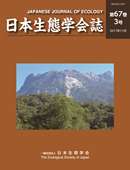All issues

Volume 67 (2017)
- Issue 3 Pages 267-
- Issue 2 Pages 75-
- Issue 1 Pages 1-
Predecessor
Volume 67, Issue 3
Displaying 1-15 of 15 articles from this issue
- |<
- <
- 1
- >
- >|
-
2017 Volume 67 Issue 3 Pages Cover1-
Published: 2017
Released on J-STAGE: December 05, 2017
JOURNAL FREE ACCESSDownload PDF (2195K) -
2017 Volume 67 Issue 3 Pages Toc1-
Published: 2017
Released on J-STAGE: December 05, 2017
JOURNAL FREE ACCESSDownload PDF (115K)
Review
-
: Basic concepts and outline of analysis procedureYasuhiro Kubota, Buntarou Kusumoto, Junichi Fujinuma, Takayuki Shiono2017 Volume 67 Issue 3 Pages 267-286
Published: 2017
Released on J-STAGE: December 05, 2017
JOURNAL FREE ACCESSSystematic conservation planning (SCP) provides a decision-support framework for biodiversity conservation for multi-stakeholder deliberation. The core concept for designing protected area (PA) networks is the CAR principle, which comprises Comprehensiveness, Adequacy, and Representativeness. This is the basis of conservation planning, involving the identification of potential biodiversity patterns within a PA network as sampled areas. Priority areas for implementing conservation targets are identified in a spatially explicit manner, based on site-selection algorithms using biodiversity features and socioeconomic cost layers. Site-selection algorithms have roots in the concept of complementarity, which is related to ecological/evolutionary distinctiveness and the spatial turnover of biodiversity features among sites. Complementarity is a conceptual attribute of site-selection algorithms used to explore the minimum-set problem. Irreplaceability constitutes an index of conservation priority, and it is informative to associate the irreplaceability score with threat/vulnerability levels among sites when using a reactive conservation approach. Spatial prioritization of the Zonation algorithm is a promising tool for defining conservation targets recursively, and enables us to prioritize ranking for minimizing biodiversity loss under socioeconomic constraints. The concept of persistence is an important one for the future development of SCP, which currently assumes static biodiversity patterns. Incorporating macroecological patterns and underlying processes into the CAR principle is critical for maintaining biogeographical potential in conservation planning.View full abstractDownload PDF (2038K) -
: Integrating different spatial scales within and among speciesYuzu Sakata, Yasuhiro Sato2017 Volume 67 Issue 3 Pages 287-306
Published: 2017
Released on J-STAGE: December 05, 2017
JOURNAL FREE ACCESSEvidence is accumulating that plant–herbivore interactions vary spatiotemporally at scales of several decades and hundreds of kilometers and that this drives the evolution of plant defense within a species. Here, we present a general review of recent examples with the aim of outlining an empirical framework for understanding the evolutionary dynamics of anti-herbivore defenses. First, we review the mechanisms shaping and maintaining variation in plant defense by focusing on two spatial scales, i.e., within and among populations. We review how biotic and abiotic factors cause divergent selection among populations and thereby shape geographic variation in plant defense. Within a plant population, we focus on how an apparent herbivore-mediated interaction maintains genetic variation in anti-herbivore defense. Then, we outline intraspecific evolutionary processes and patterns (i.e., microevolution) in plant defense by connecting the two spatial scales in terms of apparent competition. We also discuss whether major hypotheses explaining interspecific patterns of plant defense can explain microevolution and whether microevolution in plant defense links to interspecific variation via speciation. These recent findings suggest that microevolution in plant defense contributes to global and phylogenetic patterns (macroevolution) in plant defense.View full abstractDownload PDF (1213K)
Feature Mechanism of conifer dominance in tropical forests
-
: an introductionShin-ichiro Aiba, Kazuki Miyamoto2017 Volume 67 Issue 3 Pages 307-311
Published: 2017
Released on J-STAGE: December 05, 2017
JOURNAL FREE ACCESSDownload PDF (1418K) -
Shin-ichiro Aiba2017 Volume 67 Issue 3 Pages 313-321
Published: 2017
Released on J-STAGE: December 05, 2017
JOURNAL FREE ACCESS -
Yoshimi Sawada, Shin-ichiro Aiba, Tatsuyuki Seino, Kanehiro Kitayama2017 Volume 67 Issue 3 Pages 323-330
Published: 2017
Released on J-STAGE: December 05, 2017
JOURNAL FREE ACCESS -
Kazuki Miyamoto, Shin-ichiro Aiba, Rota Wagai, Nilus Reuben2017 Volume 67 Issue 3 Pages 331-337
Published: 2017
Released on J-STAGE: December 05, 2017
JOURNAL FREE ACCESS -
Root morphology, mycorrhizal fungi and nitrogen fixation activity of Podocarpaceae and AraucariaceaeMasayuki Ushio2017 Volume 67 Issue 3 Pages 339-345
Published: 2017
Released on J-STAGE: December 05, 2017
JOURNAL FREE ACCESS -
Ryota Aoyagi, Hiroki Taga2017 Volume 67 Issue 3 Pages 347-353
Published: 2017
Released on J-STAGE: December 05, 2017
JOURNAL FREE ACCESS -
Shin-ichiro Aiba, Kazuki Miyamoto, Masayuki Ushio, Ryota Aoyagi, Yoshi ...2017 Volume 67 Issue 3 Pages 355-360
Published: 2017
Released on J-STAGE: December 05, 2017
JOURNAL FREE ACCESS
From field research sites (35)
-
Yoshiyuki Miyazawa2017 Volume 67 Issue 3 Pages 361-367
Published: 2017
Released on J-STAGE: December 05, 2017
JOURNAL FREE ACCESSDownload PDF (2271K)
Museum and ecology (29)
-
Case 1: Systems to pass on the observation data of vegetation composition and constitution to coming generationsYoshinobu Hashimoto2017 Volume 67 Issue 3 Pages 369-374
Published: 2017
Released on J-STAGE: December 05, 2017
JOURNAL FREE ACCESSDownload PDF (768K)
-
2017 Volume 67 Issue 3 Pages App1-
Published: 2017
Released on J-STAGE: December 05, 2017
JOURNAL FREE ACCESSDownload PDF (189K) -
2017 Volume 67 Issue 3 Pages Toc2-
Published: 2017
Released on J-STAGE: December 05, 2017
JOURNAL FREE ACCESSDownload PDF (483K)
- |<
- <
- 1
- >
- >|